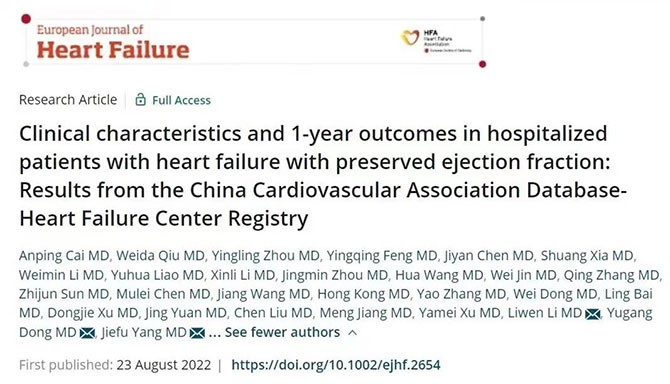

Heart failure is the serious representation and final stage of almost all kinds of heart diseases. Heart failure with preserved ejection fraction (HFpEF) accounts for about 50% of all heart failures. As the average life expectancy prolongs, the prevalence of heart failure with preserved ejection fraction will further increase. The high hospitalization and mortality rate of patients with HFpEF brings a heavy economic and medical burden to the country, society and families. There are as high as 12 million heart failure patients over 25 years old in China, accounting for about one-fifth of the total heart failure population in the world. However, there is still a lack of large-scale clinical research data on HFpEF in China.
Guangdong Provincial People's Hospital is the demonstration center of the Heart Failure Center of Chinese Cardiovascular Association and one of the most important units participating in the registry study of the Heart Failure Center. Li Liwen, Director of the Cardiovascular Medicine Department (corresponding author), Doctor Cai Anping, and Doctor Qiu Weida (co-first author) have explored the clinical characteristics of the currently hospitalized patients with HFpEF and the risk of re-hospitalization for heart failure and death due to cardiovascular disease one year after discharge from hospital in China. The study results were published in the European Journal of Heart Failure, a top professional journal in the heart failure field (IF=17.349).

The study covered 481 secondary and tertiary heart failure center-certified hospitals in 31 provincial administrative regions in the Chinese mainland, including 41,708 hospitalized patients with HFpEF from January 2017 to June 2021. The patients were 72.2 years old on average, including 49.3% women. 18.2% of them were hospitalized for heart failure in the previous year and 55.8% of them had serious heart failure symptoms (NYHA heart function classification:Ⅲ/Ⅳ). The median value of the left ventricular ejection fraction was 59%. The three most common causes of heart failure hospitalization are myocardial ischemia (26.6%), infection (14.4%) and arrhythmia (10.5%). About 67.4% of the patients had three or more comorbidities, among which hypertension (65.2%), coronary heart disease (60.3%) and atrial fibrillation (41.2%) were the most common comorbidities., The treatment of these patients by using some devices and drugs was not in accordance with the recommendations of the current heart failure guidelines. The re-hospitalization rate due to heart failure and mortality rate due to cardiovascular disease of patients with HFpEF within one year after discharge from the hospital in China is as high as 16.4% on average, with the re-hospitalization rate for heart failure of 13.6% and mortality rate due to cardiovascular disease of 3.1%. As compared with foreign studies, the prognosis of the patients with HFpEF in China is worse. Further analysis has shown that patients hospitalized for heart failure in the previous year, with blood sodium<135 mmol/L and NT-proBNP>1800 pg/ml are at higher risk of re-hospitalization for heart failure or death due to cardiovascular disease within one year.
This study is the largest clinical study of heart failure with preserved ejection fraction in China now. The study results have filled in the gap of our country in this field and will provide an important research basis for future interventions for patients with HFpEF in China. They will play an important role in improving the prognosis of patients with HFpEF in China.
Cai Anping